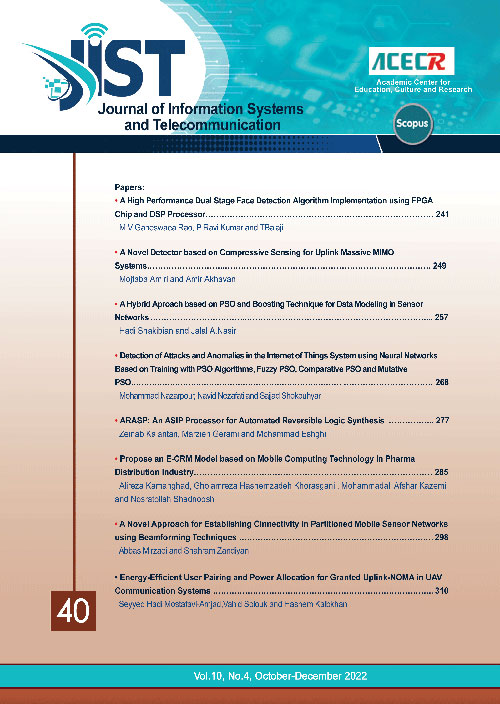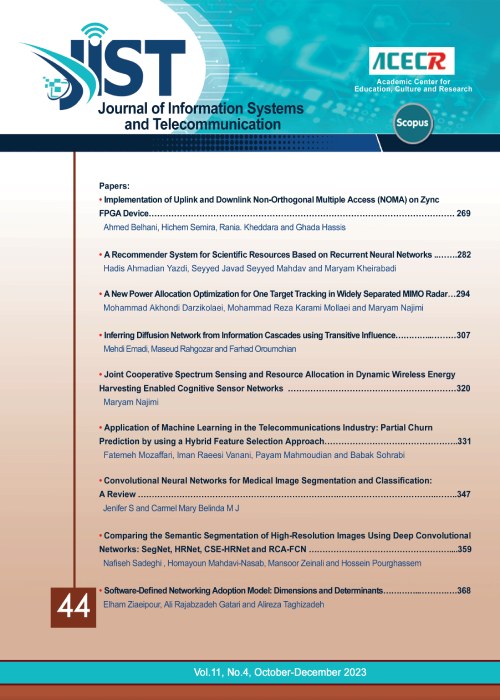فهرست مطالب

Journal of Information Systems and Telecommunication
Volume:10 Issue: 4, Oct-Dec 2022
- تاریخ انتشار: 1401/08/15
- تعداد عناوین: 8
-
-
Pages 241-248
A dual stage system architecture for face detection based on skin tone detection and Viola and Jones face detection structure is presented in this paper. The proposed architecture able to track down human faces in the image with high accuracy within time constrain. A non-linear transformation technique is introduced in the first stage to reduce the false alarms in second stage. Moreover, in the second stage pipe line technique is used to improve overall throughput of the system. The proposed system design is based on Xil inx’s Virtex FPGA chip and Texas Instruments DSP processor. The dual port BRAM memory in FPGA chip and EMIF (External Memory Interface) of DSP processor are used as interface between FPGA and DSP processor. The proposed system exploits advantages of both the computational elements (FPGA and DSP) and the system level pipelining to achieve real time perform ance. The present system implementation focuses on high accurate and high speed face detec tion and this system evaluated using standard BAO image database, which include images with different poses, orientations, occlusions and illumination. The proposed system attained 16.53 FPS frame rate for the input image spatial resolution of 640X480, which is 23.4 times faster detection of faces compared to MATLAB implementation and 12.14 times faster than DSP implementation and 2.1 times faster than FPGA implementation.
Keywords: Face detection, Heterogeneous System, FPGA, DSP -
Pages 249-256
Massive multiple-input multiple-output is a promising technology in future communication networks where a large number of antennas are used. It provides huge advantages to the future communication systems in data rate, the quality of services, energy efficiency, and spectral efficiency. Linear detection algorithms can achieve a near-optimal performance in large-scale MIMO systems, due to the asymptotic orthogonal channel property. But, the performance of linear MIMO detectors degrades when the number of transmit antennas is close to the number of receive antennas (loaded scenario). Therefore, this paper proposes a series of detectors for large MIMO systems, which is capable of achieving promising performance in loaded scenarios. The main idea is to improve the performance of the detector by finding the hidden sparsity in the residual error of the received signal. At the first step, the conventional MIMO model is converted into the sparse model via the symbol error vector obtained from a linear detector. With the aid of the compressive sensing methods, the incorrectly detected symbols are recovered and performance improvement in the detector output is obtained. Different sparse recovery algorithms have been considered to reconstruct the sparse error signal. This study reveals that error recovery by imposing sparse constraint would decrease the bit error rate of the MIMO detector. Simulation results show that the iteratively reweighted least squares method achieves the best performance among other sparse recovery methods.
Keywords: Massive MIMO, MMSE Detector, Error Recovery, Compressive Sensing, Iteratively Reweighted Least Squares (IRLS) Method -
Pages 259-269
An efficient data aggregation approach in wireless sensor networks (WSNs) is to abstract the network data into a model. In this regard, regression modeling has been addressed in many studies recently. If the limited characteristics of the sensor nodes are omitted from consideration, a common regression technique could be employed after transmitting all the network data from the sensor nodes to the fusion center. However, it is not practical nor efferent. To overcome this issue, several distributed methods have been proposed in WSNs where the regression problem has been formulated as an optimization based data modeling problem. Although they are more energy efficient than the centralized method, the latency and prediction accuracy needs to be improved even further. In this paper, a new approach is proposed based on the particle swarm optimization (PSO) algorithm. Assuming a clustered network, firstly, the PSO algorithm is employed asynchronously to learn the network model of each cluster. In this step, every cluster model is learnt based on the size and data pattern of the cluster. Afterwards, the boosting technique is applied to achieve a better accuracy. The experimental results show that the proposed asynchronous distributed PSO brings up to 48% reduction in energy consumption. Moreover, the boosted model improves the prediction accuracy about 9% on the average.
Keywords: Wireless sensor network, Distributed optimization, Particle swarm optimization, Regression, Boosting -
Pages 270-278
Integration and diversity of IOT terminals and their applicable programs make them more vulnerable to many intrusive attacks. Thus, designing an intrusion detection model that ensures the security, integrity, and reliability of IOT is vital. Traditional intrusion detection technology has the disadvantages of low detection rates and weak scalability that cannot adapt to the complicated and changing environment of the Internet of Things. Hence, one of the most widely used traditional methods is the use of neural networks and also the use of evolutionary optimization algorithms to train neural networks can be an efficient and interesting method. Therefore, in this paper, we use the PSO algorithm to train the neural network and detect attacks and abnormalities of the IOT system. Although the PSO algorithm has many benefits, in some cases it may reduce population diversity, resulting in early convergence. Therefore,in order to solve this problem, we use the modified PSO algorithm with a new mutation operator, fuzzy systems and comparative equations. The proposed method was tested with CUP-KDD data set. The simulation results of the proposed model of this article show better performance and 99% detection accuracy in detecting different malicious attacks, such as DOS, R2L, U2R, and PROB.
Keywords: Attack detection, Internet of Things (IOT), Neural Network, PSO Algorithm, Fuzzy rule, Adaptive Formulation -
Pages 279-286
Reversible logic has been emerged as a promising computing paradigm to design low power circuits in recent years. The synthesis of reversible circuits is very different from that of non-reversible circuits. Many researchers are studying methods for synthesizing reversible combinational logic. Some automated reversible logic synthesis methods use optimization algorithms Optimization algorithms are used in some automated reversible logic synthesis techniques. In these methods, the process of finding a circuit for a given function is a very time-consuming task, so it’s better to design a processor which speeds up the process of synthesis. Application specific instruction set processors (ASIP) can benefit the advantages of both custom ASIC chips and general DSP chips. In this paper, a new architecture for automatic reversible logic synthesis based on an Application Specific Instruction set Processors is presented. The essential purpose of the design was to provide the programmability with the specific necessary instructions for automated synthesis reversible. Our proposed processor that we referred to as ARASP is a 16-bit processor with a total of 47 instructions, which some specific instruction has been set for automated synthesis reversible circuits. ARASP is specialized for automated synthesis of reversible circuits using Genetic optimization algorithms. All major components of the design are comprehensively discussed within the processor core. The set of instructions is provided in the Register Transform Language completely. Afterward, the VHDL code is used to test the proposed architecture.
Keywords: Reversible logic, Optimization Algorithms, Application Specific Instruction Set Processors, ASIP, RTL -
Pages 287-299
In today’s world, the competition between all business areas and companies including pharma distributor companies has increased dramatically, so it is very important for active companies in the pharma distribution industry which deal with a large number of customers in a B2B market to establish a deep and long-term relationship with their customers and manage that relationship effectively. Since the CRM which now is enriched by new emerging technologies in terms of e-CRM and m-CRM is under developing rapidly, it can play a critical role for empowering these companies to strengthen their relationship with their customers. In this research it has been tried to have a complete review of mobile computing technology concept and its effect on CRM. The research methodology is basically qualitative. After a literature review, using qualitative research methods and deep interviews with a group of 8 industry experts, the whole concept of the initial model was derived using Thematic Analysis method. The Grounded Theory approach was applied to extract the main factors and sub-factors of the final model. Additionally, some of \research techniques such as Dematel, ANP and Super Decision software were used to investigate the interdependency, importance and priority of factors and sub-factors. At the last stage a new model for e-CRM in pharma distribution industry based on mobile computing technology has been proposed. The four key components of the model are Quality of Content and Services, Organizational Readiness, Quality of System and Communication, Customer Mobile App.
Keywords: e-CRM, m-CRM, Customer Relationship Management, Mobile Computing Technology, Pharma Distributors -
Pages 300-311
Network connectivity is one of the major design issues in the context of mobile sensor networks. Due to diverse communication patterns, some nodes lying in high-traffic zones may consume more energy and eventually die out resulting in network partitioning. This phenomenon may deprive a large number of alive nodes of sending their important time critical data to the sink. The application of data caching in mobile sensor networks is exponentially increasing as a high-speed data storage layer. This paper presents a deep learning-based beamforming approach to find the optimal transmission strategies for cache-enabled backhaul networks. In the proposed scheme, the sensor nodes in isolated partitions work together to form a directional beam which significantly increases their overall communication range to reach out a distant relay node connected to the main part of the network. The proposed methodology of cooperative beamforming-based partition connectivity works efficiently if an isolated cluster gets partitioned with a favorably large number of nodes. We also present a new cross-layer method for link cost that makes a balance between the energy used by the relay. By directly adding the accessible auxiliary nodes to the set of routing links, the algorithm chooses paths which provide maximum dynamic beamforming usage for the intermediate nodes. The proposed approach is then evaluated through simulation results. The simulation results show that the proposed mechanism achieves up to 30% energy consumption reduction through beamforming as partition healing in addition to guarantee user throughput.
Keywords: Mobile Sensor Networks (MSNs), Connectivity Restoration, Network Partitioning, Cooperative Beamforming, Fault Recovery -
Pages 312-323
With the rapid deployment of users and increasing demands for mobile data, communication networks with high capacity are needed more than ever. Furthermore, there are several challenges, such as providing efficient coverage and reducing power consumption. To tackle these challenges, using unmanned aerial vehicles (UAVs) would be a good choice. This paper proposes a scheme for uplink non-orthogonal multiple access (NOMA) in UAV communication systems in the presence of granted and grant-free users. At first, the service area users, including granted and grant-free users, are partitioned into some clusters. We propose that the hover location for each cluster is determined considering the weighted mean of users’ locations. We aim to allocate transmission power and form NOMA pairs to maximize the energy efficiency in each cluster subject to the constraints on spectral efficiency and total transmission power. To this end, the transmission powers of each possible pair are obtained, and then Hungarian matching is used to select the best pairs. Finally, finding the flight path of the UAV is modeled by the traveling salesman problem (TSP), and the genetic algorithm method obtains its solution. The results show that the increasing height of the UAV and density of users increases the spectral and energy efficiencies and reduces the outage probability. Also, considering the quality of service (QoS) of granted users for determining the UAV's hover location enhances the transmission's performance.
Keywords: Energy Efficiency, NOMA, Power Allocation, Unmanned Aerial Vehicle (UAV), Uplink, Users Pairing


